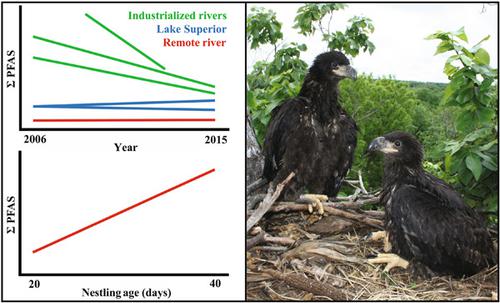当前位置:
X-MOL 学术
›
Environ. Toxicol. Chem.
›
论文详情
Our official English website, www.x-mol.net, welcomes your
feedback! (Note: you will need to create a separate account there.)
Trends and Patterns of Perfluoroalkyl Substances in Blood Plasma Samples of Bald Eagle Nestlings in Wisconsin and Minnesota, USA
Environmental Toxicology and Chemistry ( IF 3.6 ) Pub Date : 2020-08-31 , DOI: 10.1002/etc.4864 Cheryl R Dykstra 1 , William T Route 2 , Kelly A Williams 3
Environmental Toxicology and Chemistry ( IF 3.6 ) Pub Date : 2020-08-31 , DOI: 10.1002/etc.4864 Cheryl R Dykstra 1 , William T Route 2 , Kelly A Williams 3
Affiliation

|
We analyzed concentrations and trends of perfluoroalkyl substances (PFAS) in blood plasma samples of bald eagle (Haliaeetus leucocephalus) nestlings at 6 study areas in the upper Midwest of the United States, 2006 to 2015, and long‐term trends at 2 Lake Superior (USA/Canada) sites, 1995 to 2015. Nestling blood plasma concentrations of the sum of 15 PFAS analytes (∑PFAS) differed among study areas and were highest at the 3 industrialized river sites: pools 3 and 4 of the Mississippi River (pools 3 + 4; geometric mean [GM] = 754 μg/L; range = 633–2930), the Mississippi National River and Recreation Area (GM = 687 μg/L; range = 24–7371), and the lower St. Croix National Scenic Riverway (GM = 546 μg/L; range = 20–2400). Temporal trends in ∑PFAS in nestling plasma differed among study areas; concentrations decreased at pools 3 + 4, Mississippi National River and Recreation Area, and lower St. Croix National Scenic Riverway, but not at the most remote sites, the upper St. Croix River and Lake Superior. Overall, perfluorooctanesulfonate (PFOS) was the most abundant analyte at all study areas, and perfluorodecanesulfonate (PFDS) the second most abundant at industrialized river sites although not at Lake Superior; concentrations of both these analytes declined from 2006 to 2015 over the study area. In addition, nestling age significantly influenced plasma concentrations of ∑PFAS and 7 of the 12 analytes. For these analytes, concentrations increased by 1 to 2%/d as nestlings grew, indicating that age should be considered when using nestling plasma to assess PFAS. Environ Toxicol Chem 2021;40:754–766. © 2020 The Authors. Environmental Toxicology and Chemistry published by Wiley Periodicals LLC on behalf of SETAC.
中文翻译:

美国威斯康星州和明尼苏达州秃鹰雏鸟血浆样本中全氟烷基物质的趋势和模式
我们分析了白头鹰 ( Haliaeetus leucocephalus ) 血浆样本中全氟烷基物质 (PFAS) 的浓度和趋势) 2006 年至 2015 年美国中西部上游 6 个研究区域的雏鸟,以及 1995 年至 2015 年苏必利尔湖(美国/加拿大)2 个地点的长期趋势。 15 种 PFAS 分析物总和的雏鸟血浆浓度(∑PFAS) 因研究区域而异,在 3 个工业化河流站点中最高:密西西比河的第 3 和第 4 池(池 3 + 4;几何平均值 [GM] = 754 μg/L;范围 = 633–2930),密西西比国家河流和休闲区(GM = 687 μg/L;范围 = 24–7371),以及圣克罗伊国家风景河道下游(GM = 546 μg/L;范围 = 20–2400)。雏鸟血浆中 ∑PFAS 的时间趋势因研究区域而异;水池 3 + 4、密西西比国家河流和游乐区以及圣克罗伊国家风景河道下游的浓度下降,但在最偏远的地点,圣路易斯上游的浓度没有下降。克罗伊河和苏必利尔湖。总的来说,全氟辛烷磺酸( PFOS) 是所有研究区域中最丰富的分析物,全氟癸烷磺酸盐 (PFDS) 是工业化河流站点中第二丰富的分析物,尽管不是在苏必利尔湖;从 2006 年到 2015 年,研究区域内这两种分析物的浓度均有所下降。此外,雏龄显着影响 ∑PFAS 和 12 种分析物中的 7 种的血浆浓度。对于这些分析物,随着雏鸟的生长,浓度增加 1% 至 2%/d,表明在使用雏鸟血浆评估 PFAS 时应考虑年龄。环境毒理学化学2021;40:754-766。© 2020 作者。环境毒理学和化学由 Wiley Periodicals LLC 代表 SETAC 出版。
更新日期:2020-08-31
中文翻译:

美国威斯康星州和明尼苏达州秃鹰雏鸟血浆样本中全氟烷基物质的趋势和模式
我们分析了白头鹰 ( Haliaeetus leucocephalus ) 血浆样本中全氟烷基物质 (PFAS) 的浓度和趋势) 2006 年至 2015 年美国中西部上游 6 个研究区域的雏鸟,以及 1995 年至 2015 年苏必利尔湖(美国/加拿大)2 个地点的长期趋势。 15 种 PFAS 分析物总和的雏鸟血浆浓度(∑PFAS) 因研究区域而异,在 3 个工业化河流站点中最高:密西西比河的第 3 和第 4 池(池 3 + 4;几何平均值 [GM] = 754 μg/L;范围 = 633–2930),密西西比国家河流和休闲区(GM = 687 μg/L;范围 = 24–7371),以及圣克罗伊国家风景河道下游(GM = 546 μg/L;范围 = 20–2400)。雏鸟血浆中 ∑PFAS 的时间趋势因研究区域而异;水池 3 + 4、密西西比国家河流和游乐区以及圣克罗伊国家风景河道下游的浓度下降,但在最偏远的地点,圣路易斯上游的浓度没有下降。克罗伊河和苏必利尔湖。总的来说,全氟辛烷磺酸( PFOS) 是所有研究区域中最丰富的分析物,全氟癸烷磺酸盐 (PFDS) 是工业化河流站点中第二丰富的分析物,尽管不是在苏必利尔湖;从 2006 年到 2015 年,研究区域内这两种分析物的浓度均有所下降。此外,雏龄显着影响 ∑PFAS 和 12 种分析物中的 7 种的血浆浓度。对于这些分析物,随着雏鸟的生长,浓度增加 1% 至 2%/d,表明在使用雏鸟血浆评估 PFAS 时应考虑年龄。环境毒理学化学2021;40:754-766。© 2020 作者。环境毒理学和化学由 Wiley Periodicals LLC 代表 SETAC 出版。










































 京公网安备 11010802027423号
京公网安备 11010802027423号